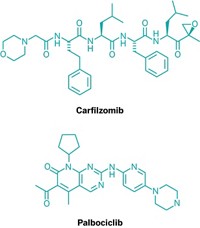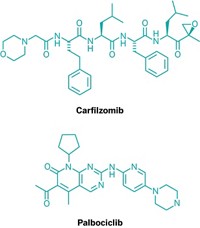Advertisement
Grab your lab coat. Let's get started
Welcome!
Welcome!
Create an account below to get 6 C&EN articles per month, receive newsletters and more - all free.
It seems this is your first time logging in online. Please enter the following information to continue.
As an ACS member you automatically get access to this site. All we need is few more details to create your reading experience.
Not you? Sign in with a different account.
Not you? Sign in with a different account.
ERROR 1
ERROR 1
ERROR 2
ERROR 2
ERROR 2
ERROR 2
ERROR 2
Password and Confirm password must match.
If you have an ACS member number, please enter it here so we can link this account to your membership. (optional)
ERROR 2
ACS values your privacy. By submitting your information, you are gaining access to C&EN and subscribing to our weekly newsletter. We use the information you provide to make your reading experience better, and we will never sell your data to third party members.
Business
Amgen's Outlook
The big biotech firm specifies how it will expand through 2015
by Lisa M. Jarvis
May 2, 2011
| A version of this story appeared in
Volume 89, Issue 18

Amgen gathered analysts and investors in New York City late last month to provide, for the first time since 2008, a comprehensive review of its business strategy through 2015. The biggest of the biotechs tried to reassure Wall Street that it intends to get a high return on its research investment. It outlined efforts to quickly grow sales of its newest drug, denosumab, expand in emerging markets, and allocate capital wisely.
Investors were happy to hear that Amgen would be doling out a dividend next quarter—the first biotech company ever to do so—but they were skeptical that it can deliver on its sales projections for denosumab and frustrated by the choices Amgen makes in its R&D spending.
When Amgen last provided a detailed long-term plan to investors, the nation was mired in the financial crisis. “We’ve come a long way in those few years as an economy,” said Chief Executive Officer Kevin W. Sharer. “Lots of questions obviously remain, but we’re not staring into the precipice anymore.”
Amgen was facing its own crisis at the time, having in 2007 experienced a sudden drop in sales of Aranesp and Epogen, proteins used to treat anemia in people with cancer or undergoing kidney dialysis. Regulators were concerned that high doses of the drugs could cause serious side effects.
Although Amgen did address the outlook for Aranesp and Epogen, which continue to face challenges, much of this meeting was devoted to denosumab. The monoclonal antibody neutralizes the RANK ligand, a switch that is key to the formation, activity, and survival of osteoclasts, the cells responsible for breaking down bone. Last June, the Food & Drug Administration approved denosumab to be sold as Prolia for postmenopausal osteoporosis. In November, the agency gave the green light to market the molecule as Xgeva to prevent fractures caused by metastases of solid tumors.
Combined sales of Prolia and Xgeva in the first quarter of 2011 were $69 million, but at the meeting Amgen spent a lot of time discussing its plans to quickly grow the franchise. The “focus on Prolia and Xgeva at every level could not be more intense,” Sharer said.
Amgen believes the two drugs will bring in $3 billion to $4 billion in revenues in 2015, a forecast that hinges on gaining approval for Xgeva in new indications and quickly launching both drugs around the globe. For example, Amgen expects to ask FDA this quarter for approval to use Xgeva to prevent the spread of prostate cancer to bones.
Use of Prolia has not picked up as quickly as expected, and Wall Street is skeptical that Amgen can deliver the rapid sales growth it is promising. Amgen has “a more bullish view of Prolia/Xgeva than the Street is willing to accept,” J. P. Morgan stock analyst Geoffrey C. Meacham wrote in a note to investors.
In a discussion of his attitude toward mergers and acquisitions, Sharer suggested he differs from many of his big pharma counterparts, who have sought acquisitions both for growth and the ability to cut costs. “We’re not interested in acquisitions that give us an opportunity for rationalization, just to take cost out,” Sharer said. “I don’t think that works.”
Amgen executives pointed to the company’s recent purchases of BioVex and Bergamo as the types of deals they will likely pursue. The BioVex purchase added a late-stage cancer immunotherapy, and Brazilian generics firm Bergamo represented more expansion into emerging markets. Amgen’s sales in emerging markets have increased from $60 million in 2005 to $350 million last year. By 2015, the company expects to bring in roughly $1 billion from emerging markets.
Another area where Amgen draws a line between itself and its peers is its commitment to R&D. Although many competitors have made significant cuts to their research budgets, Sharer said the company will continue to invest 18 to 20% of sales in R&D. “This is not an activity where you cost cut your way to success,” he said.
Investors, meanwhile, had been hoping to see Amgen focus on cost efficiency in its R&D operations and potentially drop some of its less promising discovery programs.
Prior to the meeting, Leerink Swann analyst Joshua Schimmer had conducted an in-depth analysis of Amgen’s new drug pipeline and identified compounds that he views as too similar to other drugs in development or too risky. “While we were not disappointed that high R&D spend continues, we were disappointed that there was not a clearer message that more low-value pipeline products we previously identified would be culled and replaced with higher-quality in-licensed and acquired late-stage programs,” he wrote to investors.
Amgen, however, underscored its success in R&D compared with its competitors and said it is committed to partnering and to making tough decisions about its pipeline. To be successful, Sharer said, Amgen needs to “stop projects when they won’t work, have a risk appetite, … and go outside the company nearly as often as you go inside.”




Join the conversation
Contact the reporter
Submit a Letter to the Editor for publication
Engage with us on Twitter